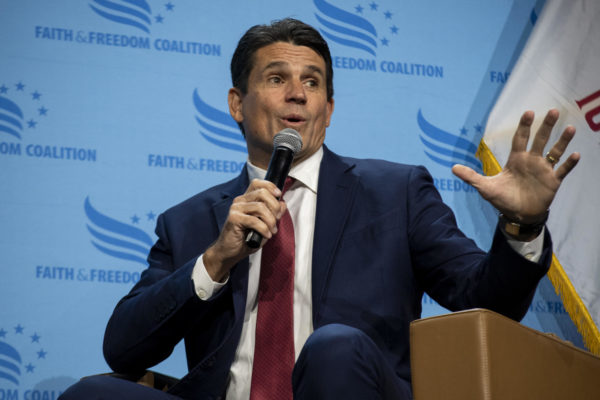BP’s Gulf well pronounced dead by U.S. officials
Photo courtesy: PO 3rd Class Barry Bena/U.S. Coast Guard via CNN Wire Service
Transocean’s Development Driller II is a relief well in the Gulf of Mexico. This well and a second well were brought in to drill relief wells in an effort to stop the flow of oil into the water after the Deepwater Horizon drilling rig explosion incident.
September 19, 2010
U.S. officials formally declared an end to the worst oil spill in U.S. history Sunday, a milestone that followed nearly five months of dashed hopes and blistering criticism of nearly everyone involved.
Well owner BP began final cementing operations to permanently plug the blowout Friday. Pressure tests conducted early Sunday confirmed the cement was holding, and the Interior Department, the agency that regulates offshore drilling, pronounced the well dead at 5:54 a.m., said former Coast Guard Adm. Thad Allen in a statement issued Sunday morning.
“With this development, which has been confirmed by the Department of the Interior’s Bureau of Ocean Energy Management, we can finally announce that the Macondo 252 well is effectively dead,” Allen, the federal government’s point man on the disaster, said in the statement.
The disaster saw oil patch jargon like “junk shot,” “static kill” and “blowout preventer” join the American lexicon, triggered shakeups in government and industry, and left residents of the Gulf Coast frustrated and worried for their livelihoods.
The disaster began with an April 20 explosion aboard the oil rig Deepwater Horizon, about 40 miles off the coast of Louisiana. The blast claimed the lives of 11 workers aboard the platform, which sank two days later in nearly a mile of water.
The rig’s blowout preventer, a massive fail-safe device at the seabed, failed to operate after the blast. Efforts to activate it using remote submarines failed. An effort to plug it with heavy drilling fluid and cement failed. A bid to jam it shut by pumping it full of debris also failed.
The well spewed an estimated 4.9 million barrels, or 206 million gallons, of crude into the Gulf of Mexico before it was temporarily capped July 15. It was permanently sealed only when BP drilled a separate relief well into the sea floor, intercepting the original well and allowing workers to fill it with cement from below.
The spill struck hard at some of the pillars of the Gulf Coast’s economy as oil washed up on beaches in Louisiana, Mississippi, Alabama and Florida; federal and state authorities shut down Gulf fisheries; and a temporary federal ban on deepwater drilling idled oil workers. More than a third of the Gulf was closed to fishing at the height of the disaster, and tourists stayed away from the region’s white sands in droves.
At the White House, President Barack Obama hailed the “final termination” of the well but said the federal government will continue to do “everything possible to make sure the Gulf Coast recovers fully from this disaster.”
“This road will not be easy, but we will continue to work closely with the people of the Gulf to rebuild their livelihoods and restore the environment that supports them,” Obama said in a written statement. “My administration will see our communities, our businesses and our fragile ecosystems through this difficult time.”
About 600 miles of shoreline has been affected by the spill, Coast Guard Rear Adm. Paul Zukunft told CNN on Saturday.
“In fact, today I have over 25,000 people out there doing very intense, in high heat conditions, cleanup along those 600 miles,” Zukunft said. “And that will continue for some period of time.”
Researchers are still trying to figure out what happened to the rest of the oil that poured out into the Gulf for 12 weeks before the temporary cap was placed over the well July 15.
Government scientists have estimated that at least 200 million gallons of oil leaked from BP’s damaged well, but 74 percent of it subsequently evaporated, broke up, or was skimmed or burned off.
Other researchers say much of the oil may have settled to the floor of the Gulf and have raised concerns about the chemical dispersants used to break up the spill.
The disaster contributed to the ouster of BP CEO Tony Hayward, who was pilloried in congressional hearings after telling reporters in Louisiana that no one wanted the issue resolved more than him — because “I want my life back.”
Hayward is being replaced by Bob Dudley, who grew up in Mississippi. Dudley said last week that the spill eventually would cost the company $32 billion.
The disaster remains under investigation by several arms of the U.S. government, including congressional committees, the Department of Justice and a Coast Guard-Interior Department panel that has held several rounds of hearings on the cause of the sinking.
BP shouldered some responsibility for the disaster after an internal investigation of the spill, but assigned much of the blame to contractors Halliburton, which cemented the well, and Transocean, which owned and operated the rig. Both Halliburton and Transocean sharply disputed the findings, arguing that BP’s well design was at the root of the blowout.
And the spill put harsh new scrutiny on the Interior Department’s regulation of offshore oil exploration, which already had been plagued by scandal during the Bush administration. The Minerals Management Service was split up into two separate agencies, one aimed at enforcing regulations and another that collected revenues. Its director at the time, Elizabeth Birnbaum, announced her resignation in May, though two sources told CNN she had been fired.















